Tan - the body's response to DNA damage
There is a myth that sunbathing is useful. However, few people know that tanning is nothing more than a protective reaction of the body in response to DNA damage from ultraviolet radiation. It is in response to the appearance of specific DNA fragments, which are the “calling card” of UV damage, that melanocytes (the very cells from which melanoma can develop) begin to produce more melanin. What is melanin, I think, many people know - this is the pigment, the concentration of which depends on the shade of skin and hair. In the skin, it plays the role of toning, literally taking fire on itself in order to protect our DNA from high-frequency photons.
Scientists divide the spectrum of UV (UV) into 3 categories: A, B and C. Most high-frequency UVC does not reach us (thanks to ozone), but the other two types are very even:
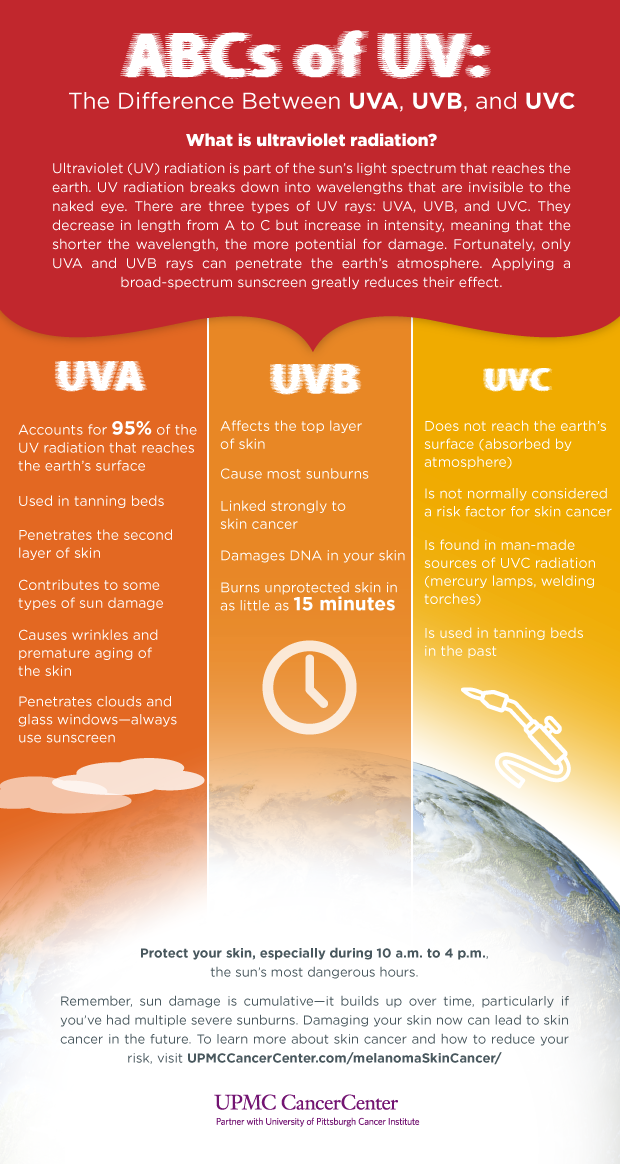
What happens when a UV photon hits our DNA? The formation of the so-called. Pyrimidine dimers - this is when one of the “letters of DNA”, inspired by the influx of forces from a photon, decides to strengthen the relationship with the twin neighbor and enters into a covalent bond with it. Such a connection may occur between two thymines or two cytosines in DNA or two uracils in RNA:

The fact that this is not good for our cells is, I think, understandable and true. Life on this planet has long been familiar with the sun, so she knows how to detect and repair such his leprosy. Most living organisms can simply “measure” these dimers. This process is called photoreactivation and there is a whole class of enzymes that are sharpened. True, alas, not in humans . Sorrow, I agree.
People have to resort to surgery : special enzymes cut out pieces of DNA with harmful dimers, and restore the cut fragment using a complementary DNA strand. The benefit of the DNA strands is two (backup is our everything), and each pyrimidine base (C or T) in the complementary strand corresponds to a base NOT pyrimidine (but purine, if any of the young chemists are interested, that is, G or A), and thus not dimerized from UV.
It is worth mentioning that the effectiveness of this reparation process significantly decreases with age , therefore, the older we become, the more dangerous for us is UV. Although with age in general, all systems work worse and worse . The program, sir. But this is not a reason to expose oneself to an increased risk of cancer by roasting in the sun in old age.
Let us return to our dimers, which are surgically removed from DNA. Because it is they who make our melanocytes produce melanin - the same pigment that paints tanned skin in a bronze color. This was established experimentally in a series of studies , the crown of which was the introduction of these same dimers into the skin of guinea pigs, which caused tanning in the latter (photo (a) below, injection sites 4-6). Inspired by these results, the authors of the work even proposed to produce a cream with such dimers as tanning. And really, if you want bronze skin so much, why wait for DNA damage for its appearance, if you can activate the tinting mechanism without them?

By the way, the process of tinting the skin is very interesting. Melanocytes sit quite deeply, at the very bottom of the epidermis, and the melanin produced by them in special “containers” rises to the upper layers of the skin, where it is embedded in skin cells (keratinocytes), and not anyhow, but forming such a Dyson anti-sphere around their cores. After all, it is in the nucleus that the DNA lives, which melanin is intended to protect, absorbing vagrants of photons heading towards it.
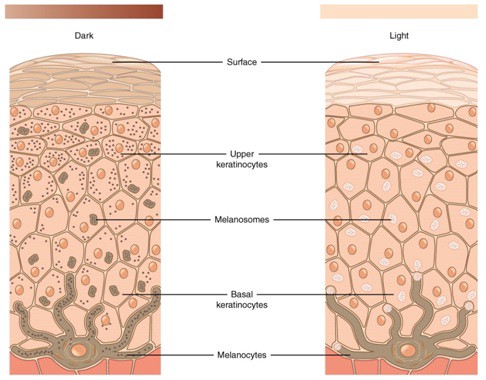
The most alarming for me is that the anti-cancer “genome guard”, p53 protein , is at the center of the mechanism between the appearance of pyrimidine dimers and the increase in melanin production. Here is a diagram of the entire cascade, showing how DNA damage from UV in skin cells activates proopiomelanocortin prohormone transcription (POMC in the graph below), which further through alpha melanocyte stimulating hormone causes melanocytes to produce more melanin.

By the way, it is p53 that decides to try to repair DNA breaks in a cell or to send it to another world, that is, to apoptosis. And billions of cells are recovering as a result of strong tanning : exactly this fate is the cause of the skin that peels off after tanning. Peeling, however, this is the final part of Marlezonskogo ballet. The first reaction to an excessive dose of UV radiation is an active inflammatory process that begins literally minutes after irradiation:
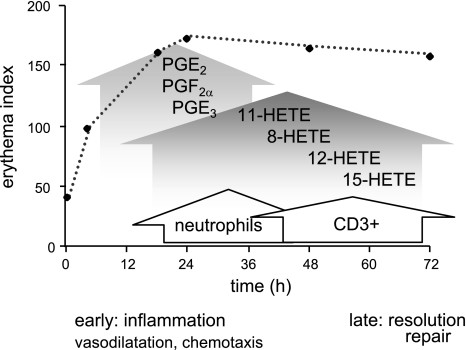
Erythema, the index of which is shown in the diagram above, is reddening of the skin, a well-known marker of inflammation. Therefore, the fact that during “burning” (or “ sunburn ”, if scientifically) you are red as cancer means that you have started an active inflammatory process. A few hours after it began, a concentration of prostaglandins and other pro-inflammatory cytokines will rise, and the skin will begin to ache. But never mind, we are on vacation, brush it with aloe vera, we blunt the pain with alcohol, and the next day we’ll be back in the toned system. At least, that’s what I did when I was young.
In general, vacation is a rather dangerous event. Our company receives blows repeatedly and from different sides. This siege begins on the way there: airports and airplanes are well-known breeding grounds for infection. Then, many-day overeating and exorbitant libations make their contribution (this is especially relevant for trips to the “all-inclusive” boarding houses), and after a couple of days of active beach rest, chronic inflammation from excessive sunburn is activated. On the way home, aircraft bacteria and viruses are waiting in the wings, moreover, after adjusting for the fact that after a multi-day siege, the body’s defensive functions may not be the same as on the way there.
And this is not taking into account the increased risk of melanoma from "combustion". And it rises significantly, almost twice :
Moreover, it is curious that those who are constantly in the sun have a slightly lower chance of melanoma (by 14%) than those who do not tan. I think the point is that such people already produce melanin to the maximum and it protects the skin from further DNA damage. And the one who sunbathes, does not sunbathe, each time must first go through the phase of new DNA breakdowns, without which the production of melanin will not increase. And it is these very breakdowns that increase the risk of skin cancer.
By the way, do not think that tanning beds are less dangerous than being in the sun. On the contrary, the risk of melanoma from them is even higher :
Someone may argue that the risk of melanoma is not originally so great, about a hundredth of a percent per year:

However, we should not forget that the probability of getting melanoma during life is about 2.5%, and all types of skin cancer - 20%. And for older people, cancer is the second biggest killer after cardiovascular diseases, 20-40% of people over 45 die of it:
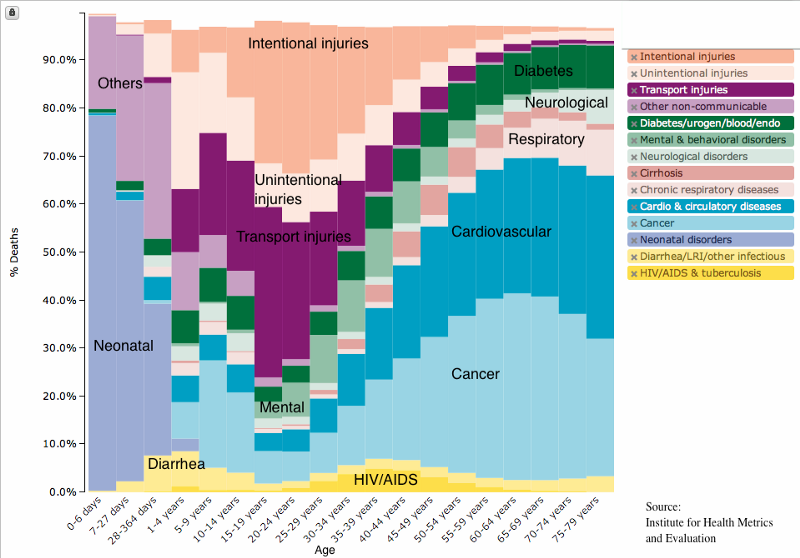
Okay, with the risks of excess UV, I think everything is clear. Is there any benefit from the sun? “Vitamin D!” Shout from the audience. But it's not so simple. First, even if vitamin D is really beneficial, it is not necessary to roast in the sun to get it. Just look in the nearest pharmacy. Secondly, its use is still not obvious. No, no, the fact that there is a correlation between the low levels of vitamin D and the high level of all kinds of ills is a fact. But the fact that low levels of vitamin D is their cause is questionable. And several studies that tried to prove the benefits of a targeted increase in the level of vitamin D have not yet been crowned with particular success: 1 , 2 , 3 , 4 , 5 . It may be that trying to specifically increase vitamin D in the hope of improving health is akin to painting over gray hair for the purpose of rejuvenation.
Okay, what if we abstract from vitamin D? Is there a correlation between being in the sun and mortality? Swedish scientists tried to establish this by interviewing 30 thousand women about their typical level of insolation and observing their mortality for the next 20 years (these Swedes are patient, you will not say anything). But despite the loud statements by the authors, there was not much difference between those who avoided the sun in general, and those who sunbathed in full:

As can be seen from the graphs, for the youngest groups, in which there were more than all respondents, the difference in life expectancy was less than a year. At the same time, the cohorts of sunburns and those that avoided the sun were very different. Those who avoided the sun (the first column in the table below) were much older, poor and sick (comorbidity is 3 times higher, and this is the percentage of those who took anti-diabetic, anticoagulant or cardiovascular drugs for more than a month) than the sunbath (the last column):
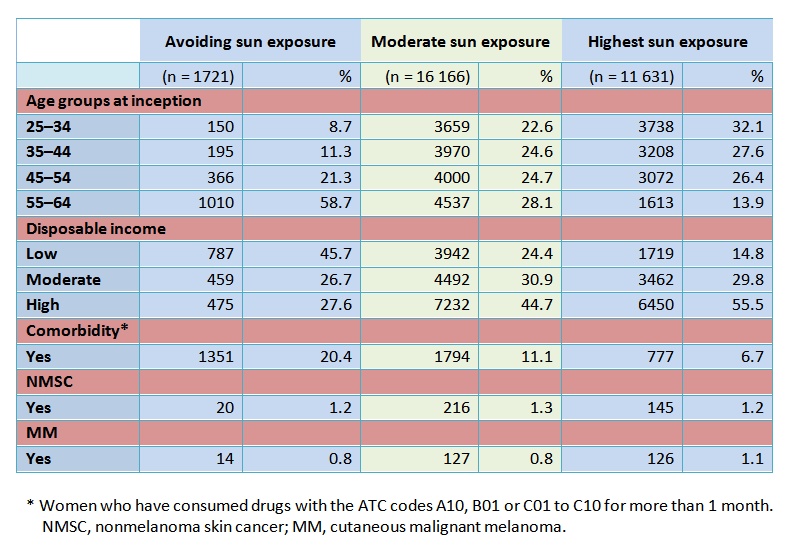
At the same time, it is not clear why the age categories 65-74 and 75-84 are present above the survival graphs, and there are no cohorts in the table with the cohort parameters.
Well, God bless them, with Swedish women. It seems that for their mortality it is not so important - sunbathe, do not sunbathe ... But for myself, at the moment I have decided the following. Is tanning helpful? Sure not. Is tanning harmful? Maybe . Based on these prerequisites, the only right decision seems to me to avoid it. So wear sunscreen !
Scientists divide the spectrum of UV (UV) into 3 categories: A, B and C. Most high-frequency UVC does not reach us (thanks to ozone), but the other two types are very even:

What happens when a UV photon hits our DNA? The formation of the so-called. Pyrimidine dimers - this is when one of the “letters of DNA”, inspired by the influx of forces from a photon, decides to strengthen the relationship with the twin neighbor and enters into a covalent bond with it. Such a connection may occur between two thymines or two cytosines in DNA or two uracils in RNA:

The fact that this is not good for our cells is, I think, understandable and true. Life on this planet has long been familiar with the sun, so she knows how to detect and repair such his leprosy. Most living organisms can simply “measure” these dimers. This process is called photoreactivation and there is a whole class of enzymes that are sharpened. True, alas, not in humans . Sorrow, I agree.
People have to resort to surgery : special enzymes cut out pieces of DNA with harmful dimers, and restore the cut fragment using a complementary DNA strand. The benefit of the DNA strands is two (backup is our everything), and each pyrimidine base (C or T) in the complementary strand corresponds to a base NOT pyrimidine (but purine, if any of the young chemists are interested, that is, G or A), and thus not dimerized from UV.
It is worth mentioning that the effectiveness of this reparation process significantly decreases with age , therefore, the older we become, the more dangerous for us is UV. Although with age in general, all systems work worse and worse . The program, sir. But this is not a reason to expose oneself to an increased risk of cancer by roasting in the sun in old age.
Let us return to our dimers, which are surgically removed from DNA. Because it is they who make our melanocytes produce melanin - the same pigment that paints tanned skin in a bronze color. This was established experimentally in a series of studies , the crown of which was the introduction of these same dimers into the skin of guinea pigs, which caused tanning in the latter (photo (a) below, injection sites 4-6). Inspired by these results, the authors of the work even proposed to produce a cream with such dimers as tanning. And really, if you want bronze skin so much, why wait for DNA damage for its appearance, if you can activate the tinting mechanism without them?

By the way, the process of tinting the skin is very interesting. Melanocytes sit quite deeply, at the very bottom of the epidermis, and the melanin produced by them in special “containers” rises to the upper layers of the skin, where it is embedded in skin cells (keratinocytes), and not anyhow, but forming such a Dyson anti-sphere around their cores. After all, it is in the nucleus that the DNA lives, which melanin is intended to protect, absorbing vagrants of photons heading towards it.

The most alarming for me is that the anti-cancer “genome guard”, p53 protein , is at the center of the mechanism between the appearance of pyrimidine dimers and the increase in melanin production. Here is a diagram of the entire cascade, showing how DNA damage from UV in skin cells activates proopiomelanocortin prohormone transcription (POMC in the graph below), which further through alpha melanocyte stimulating hormone causes melanocytes to produce more melanin.

By the way, it is p53 that decides to try to repair DNA breaks in a cell or to send it to another world, that is, to apoptosis. And billions of cells are recovering as a result of strong tanning : exactly this fate is the cause of the skin that peels off after tanning. Peeling, however, this is the final part of Marlezonskogo ballet. The first reaction to an excessive dose of UV radiation is an active inflammatory process that begins literally minutes after irradiation:

Erythema, the index of which is shown in the diagram above, is reddening of the skin, a well-known marker of inflammation. Therefore, the fact that during “burning” (or “ sunburn ”, if scientifically) you are red as cancer means that you have started an active inflammatory process. A few hours after it began, a concentration of prostaglandins and other pro-inflammatory cytokines will rise, and the skin will begin to ache. But never mind, we are on vacation, brush it with aloe vera, we blunt the pain with alcohol, and the next day we’ll be back in the toned system. At least, that’s what I did when I was young.
In general, vacation is a rather dangerous event. Our company receives blows repeatedly and from different sides. This siege begins on the way there: airports and airplanes are well-known breeding grounds for infection. Then, many-day overeating and exorbitant libations make their contribution (this is especially relevant for trips to the “all-inclusive” boarding houses), and after a couple of days of active beach rest, chronic inflammation from excessive sunburn is activated. On the way home, aircraft bacteria and viruses are waiting in the wings, moreover, after adjusting for the fact that after a multi-day siege, the body’s defensive functions may not be the same as on the way there.
And this is not taking into account the increased risk of melanoma from "combustion". And it rises significantly, almost twice :
Sun exposure and 21 on sunburn. Overall, there was a significant positive association (interplaced ratio) (OR = 0.86) for intermittent exposure (OR = 1.16) . There was a significant increase in risk of life for children in the adult life (OR = 1.91) and there was a similarly elevated risk for sunburn in adolescence (OR = 1.73) and in childhood (OR = 1.95).
Moreover, it is curious that those who are constantly in the sun have a slightly lower chance of melanoma (by 14%) than those who do not tan. I think the point is that such people already produce melanin to the maximum and it protects the skin from further DNA damage. And the one who sunbathes, does not sunbathe, each time must first go through the phase of new DNA breakdowns, without which the production of melanin will not increase. And it is these very breakdowns that increase the risk of skin cancer.
By the way, do not think that tanning beds are less dangerous than being in the sun. On the contrary, the risk of melanoma from them is even higher :
Among 1167 cases and 1101 controls, 62.9% of cases and 51.1% of controls had tanned indoors (adjusted OR 1.74, 95% CI 1.42-2.14). Melanoma risk was pronounced among users of UVB-enhanced (adjusted OR 2.86, 95% CI 2.03–4.03) and above all UVA-emitting devices (adjusted OR 4.44, 95% CI 2.45, 8.02). Risk increased with use: years (p <0.006), hours (p <0.0001), or sessions (p = 0.0002). Odds ratios were elevated within each initiation age category; years used for melanoma development.
Someone may argue that the risk of melanoma is not originally so great, about a hundredth of a percent per year:

However, we should not forget that the probability of getting melanoma during life is about 2.5%, and all types of skin cancer - 20%. And for older people, cancer is the second biggest killer after cardiovascular diseases, 20-40% of people over 45 die of it:

Okay, with the risks of excess UV, I think everything is clear. Is there any benefit from the sun? “Vitamin D!” Shout from the audience. But it's not so simple. First, even if vitamin D is really beneficial, it is not necessary to roast in the sun to get it. Just look in the nearest pharmacy. Secondly, its use is still not obvious. No, no, the fact that there is a correlation between the low levels of vitamin D and the high level of all kinds of ills is a fact. But the fact that low levels of vitamin D is their cause is questionable. And several studies that tried to prove the benefits of a targeted increase in the level of vitamin D have not yet been crowned with particular success: 1 , 2 , 3 , 4 , 5 . It may be that trying to specifically increase vitamin D in the hope of improving health is akin to painting over gray hair for the purpose of rejuvenation.
Okay, what if we abstract from vitamin D? Is there a correlation between being in the sun and mortality? Swedish scientists tried to establish this by interviewing 30 thousand women about their typical level of insolation and observing their mortality for the next 20 years (these Swedes are patient, you will not say anything). But despite the loud statements by the authors, there was not much difference between those who avoided the sun in general, and those who sunbathed in full:

As can be seen from the graphs, for the youngest groups, in which there were more than all respondents, the difference in life expectancy was less than a year. At the same time, the cohorts of sunburns and those that avoided the sun were very different. Those who avoided the sun (the first column in the table below) were much older, poor and sick (comorbidity is 3 times higher, and this is the percentage of those who took anti-diabetic, anticoagulant or cardiovascular drugs for more than a month) than the sunbath (the last column):

At the same time, it is not clear why the age categories 65-74 and 75-84 are present above the survival graphs, and there are no cohorts in the table with the cohort parameters.
Well, God bless them, with Swedish women. It seems that for their mortality it is not so important - sunbathe, do not sunbathe ... But for myself, at the moment I have decided the following. Is tanning helpful? Sure not. Is tanning harmful? Maybe . Based on these prerequisites, the only right decision seems to me to avoid it. So wear sunscreen !
All Articles